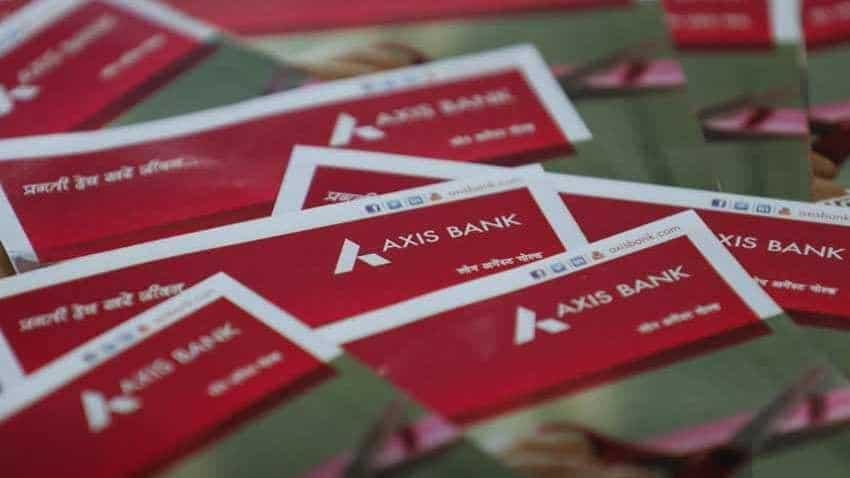Should you buy, hold or sell Axis Bank shares post Q4FY19? Here is what experts think
Among major key highlights of Axis Bank result was that, loan and deposit book grew consistently, while improvement was witnessed in asset quality which led to bag a profit compared to losses recorded a year ago same period.

After booking profit, reducing provisions and posting stable gross NPA, Axis Bank was one of the preferred stock on Dalal Street. One of the key highlights of Axis Bank result was that, loan and deposit book grew consistently, while improvement was witnessed in asset quality which helped to bag a profit against losses recorded a year ago. However, on qoq, Axis Bank's Q4FY19 earnings were negative. Thereby, the real question is whether one should buy or sell Axis Bank post Q4FY19. Interestingly, analysts have different opinions.
Expert from Dalal and Broacha Research said, "We believe stable NIMs, a strong growth profile, low cost of funds supported by high CASA and RAROC based credit pricing strategy will help Axis bank to deliver robust performance in the near-to-medium term. We expect total business to grow at CAGR 17% in FY18-21E, with growth in advances and deposits at ~16% and ~17% respectively. Thus, we have assigned a 'Buy’ rating on Axis Bank with a price target of Rs 904, valuing the stock at 2.9x FY21E standalone P/BV and ascribing a value of Rs 42 for subsidiaries."
On the other hand, Reliance Securities said, "Looking ahead, we expect the Bank to deliver sustained improvement in operating metrics led by decline in credit costs, sustained balance sheet growth, and improvement in operating efficiency. Consequently, ROE/RoA is expected to improve to 16%/1.5% for FY21E against 7%/0.6% for FY19E. Our earnings estimate for FY20E has been revised lower, factoring in the additional provisioning requirements against non-banking asset over the next three quarters. With positives largely priced in valuations, we maintain our HOLD recommendation on the stock with a revised target price of Rs 800 (from 820 earlier), valuing the stock at 2.5x FY21E ABV."
Surprisingly, Kotak Institutional Equities said, "We maintain REDUCE rating with a fair value of Rs 730 (from Rs 720 earlier) valuing the stock at 2.2X book and 13X March 2021E EPS for RoEs of ~16-17%. We expect normalization in business by FY2020. Stretched and sustainable RoE target of 18% has raised expectations for investors to expand valuations over the past year but the risk of disappointment is quite high, especially if the RoE trajectory is slower than expected. We like all the changes and decisions taken by the senior management but would be comfortable at a lower multiple than what the stock is trading at currently."
In Q4FY19, the bank bagged a net profit of Rs 1,505.06 crore compared net loss of Rs 2,188.74 crore posted a year ago same period. However, Q4FY19 PAT was down by 10.45% from Rs 1,680.85 crore. NII was at Rs 5,705.59 crore in the latest quarter versus loss of Rs 2,788.66 crore in Q4FY18. For FY19, net profit stood at Rs 4,677 crores, while NII grew by 17% YOY to Rs 21,708 crores. Net interest margin for Q4FY19 stood at 3.44%, NIM for FY19 stood at 3.43%.
Bank has recognised slippages of Rs 3,012 crores during Q4FY19, compared to Rs 3,746 crores in Q3FY19 and Rs 16,536 crores in Q4FY18. Gross NPA stood at Rs 29,789 crores and Net NPA stood at Rs 11,276 crores. Recoveries and upgrades from NPAs during the quarter were Rs 2,376 crores while write-offs were Rs 1,701 crores. Provision coverage, as a proportion of Gross NPAs including prudential write-offs, stood at 77% up from 75% in Q3FY19.
Get Latest Business News, Stock Market Updates and Videos; Check your tax outgo through Income Tax Calculator and save money through our Personal Finance coverage. Check Business Breaking News Live on Zee Business Twitter and Facebook. Subscribe on YouTube.
RECOMMENDED STORIES

Tamil Nadu Weather Alert: Chennai may receive heavy rains; IMD issues yellow & orange alerts in these districts

SIP vs PPF: How much corpus you can build in 15 years by investing Rs 1.5 lakh per year? Understand through calculations

SIP+SWP: Rs 10,000 monthly SIP for 20 years, Rs 25 lakh lump sum investment, then Rs 2.15 lakh monthly income for 25 years; see expert calculations

Top 7 Mutual Funds With Highest Returns in 10 Years: Rs 10 lakh investment in No 1 scheme has turned into Rs 79,46,160 in 10 years

SBI Senior Citizen Latest FD Rates: What senior citizens can get on Rs 7 lakh, Rs 14 lakh, and Rs 21 lakh investments in Amrit Vrishti, 1-, 3-, and 5-year fixed deposits
10:05 AM IST










 SEBI sends notices to Axis Bank, Axis Securities, Axis Capital over Max Life deal; more pain ahead for investors?
SEBI sends notices to Axis Bank, Axis Securities, Axis Capital over Max Life deal; more pain ahead for investors? Axis Bank shares zoom up 4% despite weak Q2; Here's what global brokerages suggest
Axis Bank shares zoom up 4% despite weak Q2; Here's what global brokerages suggest Axis Bank Q2 preview: PAT likely to increase 8.5% YoY; asset quality may be affected marginally
Axis Bank Q2 preview: PAT likely to increase 8.5% YoY; asset quality may be affected marginally Explained: What prompted SEBI to flag Axis Capital’s underwriting activity & guarantee
Explained: What prompted SEBI to flag Axis Capital’s underwriting activity & guarantee